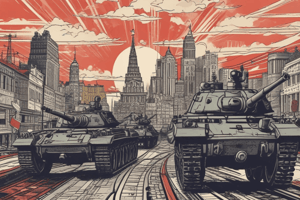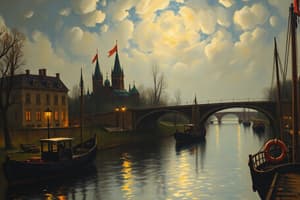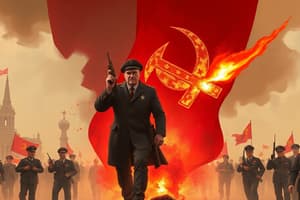Podcast
Questions and Answers
Which of the following best describes the core ideology shared by various communist movements in the 20th century?
Which of the following best describes the core ideology shared by various communist movements in the 20th century?
- Belief in free-market capitalism as the means to achieve social equality.
- Derivation from European Marxism, minimizing national loyalty and advocating for a worldwide socialist federation. (correct)
- Emphasis on national loyalty and preservation of traditional hierarchies.
- Focus on maintaining the power of religious institutions and promoting spiritual growth.
How did the Bolsheviks capitalize on the situation in Russia to gain popular support during the 1917 Revolution?
How did the Bolsheviks capitalize on the situation in Russia to gain popular support during the 1917 Revolution?
- By promising land redistribution to peasants, worker control of factories, an end to the war, and self-determination for non-Russian nationalities. (correct)
- By promising to maintain Russia's commitment to World War I and upholding the authority of the Provisional Government.
- By advocating for the continuation of the monarchy and the suppression of dissenting voices.
- By prioritizing the interests of the aristocracy and wealthy landowners over the needs of the general population.
What distinguished the communist revolutions from the French Revolution?
What distinguished the communist revolutions from the French Revolution?
- Limiting the impact of the revolution to the upper classes only.
- A rejection of utopian ideals and a preference for maintaining the status quo.
- A focus on preserving the power and privilege of the aristocracy.
- Commitment to an industrialized future with economic and political equality and the abolition of private property. (correct)
In what way did the Japanese invasion during WWII inadvertently aid the Chinese Communist Party (CCP) in gaining political power?
In what way did the Japanese invasion during WWII inadvertently aid the Chinese Communist Party (CCP) in gaining political power?
What was the primary goal of communist regimes when initially establishing socialism?
What was the primary goal of communist regimes when initially establishing socialism?
In both China and the Soviet Union, what was a significant barrier that women encountered despite the initial advancements promoted by communist ideology?
In both China and the Soviet Union, what was a significant barrier that women encountered despite the initial advancements promoted by communist ideology?
In what key way did collectivization in China differ from that in the Soviet Union?
In what key way did collectivization in China differ from that in the Soviet Union?
How did the Soviet Union's approach to equality change over time, and what was Stalin's response to this?
How did the Soviet Union's approach to equality change over time, and what was Stalin's response to this?
What was the main goal of the Cultural Revolution in China?
What was the main goal of the Cultural Revolution in China?
What was a major environmental impact of communist regimes?
What was a major environmental impact of communist regimes?
What was the primary purpose of the Great Purges in the Soviet Union?
What was the primary purpose of the Great Purges in the Soviet Union?
What was the key difference between the Cold War and a typical war?
What was the key difference between the Cold War and a typical war?
How did the existence of nuclear weapons affect the relationship between the United States and the Soviet Union during the Cold War?
How did the existence of nuclear weapons affect the relationship between the United States and the Soviet Union during the Cold War?
How were newly independent countries affected by the Cold War?
How were newly independent countries affected by the Cold War?
What was a significant weakness of the communist world by the 1970s?
What was a significant weakness of the communist world by the 1970s?
What was a notable strength of the communist world by the 1970s?
What was a notable strength of the communist world by the 1970s?
What were the two major failures of communist regimes that eventually contributed to their downfall?
What were the two major failures of communist regimes that eventually contributed to their downfall?
What types of reforms occurred in China under Deng Xiaoping's leadership?
What types of reforms occurred in China under Deng Xiaoping's leadership?
What were some of the negative outcomes in China from those reforms?
What were some of the negative outcomes in China from those reforms?
What did glasnost in the Soviet Union involve?
What did glasnost in the Soviet Union involve?
What kind of economic system characterized the Soviet Union in the 1980s?
What kind of economic system characterized the Soviet Union in the 1980s?
Why did the new freedoms under glasnost backfire on Gorbachev?
Why did the new freedoms under glasnost backfire on Gorbachev?
How did the events in Eastern Europe contribute to the downfall of the Soviet Union?
How did the events in Eastern Europe contribute to the downfall of the Soviet Union?
What occurred in China as a result of the Marriage Law?
What occurred in China as a result of the Marriage Law?
What was the purpose of Comintern?
What was the purpose of Comintern?
What did the term "Iron Curtain" refer to?
What did the term "Iron Curtain" refer to?
What was the Warsaw Pact?
What was the Warsaw Pact?
What was the Great Leap Forward?
What was the Great Leap Forward?
According to Marxist theory, what distinguishes communism from socialism?
According to Marxist theory, what distinguishes communism from socialism?
What was the goal of Perestroika?
What was the goal of Perestroika?
What was a fundamental promise of communism?
What was a fundamental promise of communism?
What inspired the key ideas of modern communism?
What inspired the key ideas of modern communism?
What was the initial task of communist regimes attempting to establish a socialist society?
What was the initial task of communist regimes attempting to establish a socialist society?
What happened to supporters of the Guomindang after the CCP took power in China?
What happened to supporters of the Guomindang after the CCP took power in China?
When did global communism and the Cold War between the US and Soviet Union officially end?
When did global communism and the Cold War between the US and Soviet Union officially end?
What inspired the communist revolutions of the 20th century?
What inspired the communist revolutions of the 20th century?
What was the first communist country?
What was the first communist country?
Who was the American President during the end of the Cold War?
Who was the American President during the end of the Cold War?
Flashcards
Communism: Promise vs. Reality
Communism: Promise vs. Reality
Promised equality and abundance for all, but created uncertain economic life and a few privileged.
US and Soviet Union
US and Soviet Union
A global rivalry during the Cold War.
Communism (Marxist theory)
Communism (Marxist theory)
Equality and collective living fully developed, without private property.
Socialism (Marxist theory)
Socialism (Marxist theory)
Signup and view all the flashcards
Ideology Definition
Ideology Definition
Signup and view all the flashcards
Common Communist Ideology
Common Communist Ideology
Signup and view all the flashcards
Purpose of the Comintern
Purpose of the Comintern
Signup and view all the flashcards
Communist Equivalent of NATO
Communist Equivalent of NATO
Signup and view all the flashcards
Inspired Communist Revolutions
Inspired Communist Revolutions
Signup and view all the flashcards
Unique Characteristics of Communist Revolutions
Unique Characteristics of Communist Revolutions
Signup and view all the flashcards
When did the Russian Revolution occur?
When did the Russian Revolution occur?
Signup and view all the flashcards
Bolshevik Promises
Bolshevik Promises
Signup and view all the flashcards
Immediate Result of Bolshevik Takeover
Immediate Result of Bolshevik Takeover
Signup and view all the flashcards
New Name for Russia
New Name for Russia
Signup and view all the flashcards
When did the communist revolution occur in China?
When did the communist revolution occur in China?
Signup and view all the flashcards
Leader of the Communist Party (China)
Leader of the Communist Party (China)
Signup and view all the flashcards
What was Guomindang?
What was Guomindang?
Signup and view all the flashcards
How did the CCP gain the support of women?
How did the CCP gain the support of women?
Signup and view all the flashcards
CCP's Address to Peasant Exploitation
CCP's Address to Peasant Exploitation
Signup and view all the flashcards
First Task of Communist Regimes
First Task of Communist Regimes
Signup and view all the flashcards
Collectivism Definition
Collectivism Definition
Signup and view all the flashcards
Women's Opportunities in Soviet Union
Women's Opportunities in Soviet Union
Signup and view all the flashcards
Opportunities for Women in China
Opportunities for Women in China
Signup and view all the flashcards
Differences in Collectivization: China vs. Soviet Union
Differences in Collectivization: China vs. Soviet Union
Signup and view all the flashcards
Model of Industrializing
Model of Industrializing
Signup and view all the flashcards
Equality Over Time in the Soviet Union
Equality Over Time in the Soviet Union
Signup and view all the flashcards
Purpose of the Cultural Revolution in China.
Purpose of the Cultural Revolution in China.
Signup and view all the flashcards
Enemies of the State
Enemies of the State
Signup and view all the flashcards
Great Purges in the Soviet Union
Great Purges in the Soviet Union
Signup and view all the flashcards
Gulag Definition
Gulag Definition
Signup and view all the flashcards
US and Soviet Union Conflict after WWII
US and Soviet Union Conflict after WWII
Signup and view all the flashcards
Iron Curtain Definition
Iron Curtain Definition
Signup and view all the flashcards
Three Acts of Global Communism's End
Three Acts of Global Communism's End
Signup and view all the flashcards
Date of Communism's Official End
Date of Communism's Official End
Signup and view all the flashcards
Reforms in China Under Deng Xiaoping
Reforms in China Under Deng Xiaoping
Signup and view all the flashcards
Explain “perestroika”
Explain “perestroika”
Signup and view all the flashcards
Explain “glasnost”
Explain “glasnost”
Signup and view all the flashcards
Communist Control in Eastern Europe Under Gorbachev
Communist Control in Eastern Europe Under Gorbachev
Signup and view all the flashcards
How was the collapse of the Soviet Union a unique phenomenon?
How was the collapse of the Soviet Union a unique phenomenon?
Signup and view all the flashcards
Study Notes
- Communism promised equality and abundance, but often resulted in economic uncertainty and privilege for a few.
- The Cold War was a global rivalry between the US and the Soviet Union.
Global Communism
- Karl Marx inspired modern communism.
- True communists believed revolution was necessary to achieve reform.
- Communism is the final stage of Marxism, with social equality and collective living fully developed without private property.
- Socialism is an intermediate stage on the way to communism.
- By 1970, one-third of the world's population lived in societies governed by a communist regime, with the Soviet Union and China being the largest.
- Ideology is defined as a set of opinions or beliefs of a group or an individual.
- Communism shared a common ideology derived from European Marxism, minimizing national loyalty and prioritizing revolution of the lower classes and a worldwide socialist federation.
- The Comintern aimed to control the policies and actions of Soviet Communist Parties.
- The Warsaw Pact was the communist equivalent of the NATO alliance, countering NATO and European capitalism.
- A Treaty of Friendship existed between Russia and China.
Revolutions as a Path to Communism
- The Russian Revolution of 1917 and Chinese revolutions inspired communist revolutions of the 20th century.
- Communist revolutions mirrored the French Revolution in seeking a better world through human action, disposing of landlords and ruling classes, involving peasant upheavals, envisioning a utopia, and risking military dictatorship.
- Communist revolutions were unique due to their highly organized parties, commitment to an industrial future, pursuit of economic and political equality, abolition of private property, disproportionate impact on the middle class, and focus on gender equality.
Russia: Revolution in a Single Year
- The Russian Revolution occurred in 1917.
- Underlying causes included pressures from WWI.
- Soldiers resented officials and deserted work.
- Factory workers seized factories through trade unions.
- Peasants seized landlords' estates and redistributed land.
- The Bolsheviks, a small socialist party, capitalized on impatience and outrage against the Provisional Government to seize power.
- Vladimir Ulyanov (Lenin) led the Bolsheviks.
- The Bolsheviks promised to end the war, give land to peasants, ensure workers control factories, and provide self-determination for non-Russian nationalities.
- Immediately after the Bolshevik takeover in October 1917, Russia experienced a three-year civil war against tsarist officials, landlords, socialists, nationalists, and foreign powers.
- After the civil war, Russia was known as the Union of Soviet Socialist Republics (USSR).
- Communism was imposed on Eastern Europe from the outside by Stalin after WWII to create friendly governments and prevent invasion from the West.
China: A Prolonged Revolutionary Struggle
- The communist revolution in China occurred in 1949.
- Differences between the Chinese and Russian revolutions include the collapse of the Chinese imperial system in 1911, the initial obscurity of Karl Marx's ideas, and the formation of the CCP in 1921.
- Mao Zedong led the communist party in China.
- The Guomindang was the nationalist party governing China after 1928.
- Positive impacts included promoting modern development.
- Negative impacts: It left rural areas impoverished and relied on support from elites, landlords, and Western powers.
- The Chinese Communist Party (CCP) gained popularity by focusing on peasants, using guerrilla warfare, experimenting with land reform, and creating a communist military force.
- The CCP gained the support of women through a theoretical commitment to liberation, the Marriage Law outlawing arranged marriage, easier divorce processes, and the right to vote and own property.
- Increased literacy resulted, but resistance was encountered with men stopping women from divorcing men on active military duty and land deeds being given to men while women were limited to work.
- Japan’s invasion of China during WWII aided the CCP by weakening Guomindang control, making them dependent on conservative landlords, and allowing the CCP to provide security, reduce costs for peasants, increase literacy, and mobilize women.
- The CCP addressed peasant exploitation by encouraging poor peasants to speak in public meetings and settle accounts with landlords.
- Supporters of the Guomindang fled to Taiwan after the CCP took power.
Building Socialism
- The initial tasks of communist regimes included modernizing/industrializing, addressing gender inequality, preventing emerging inequalities, and promoting selflessness and collectivism.
- Society was to be transformed to accommodate socialist modernity.
- Elites had to demonstrate loyalty and selflessness.
- Totalitarian party control existed, and independent organizations were prohibited.
- Collectivism meant people owned the means of production, prioritizing the group over the individual.
- Politics involved media control to promote approved ways of thinking.
- Differences characterized socialist development in China and the Soviet Union:
- The Bolsheviks faced hostile capitalism alone, while the Chinese had a friendly Soviet neighbor.
- Chinese revolutionaries had governed longer.
- Chinese support came from rural peasants, while Russian support came from cities.
- Economic differences included:
- Greater Chinese population, smaller industrial base, and limited land availability.
- Less developed Chinese literacy, education, and transportation.
- The need for China to build a modern society from the ground up.
Communist Feminism
- Opportunities for women after communist takeovers:
- Soviet Union: Political equality, consensual marriage, abortion/divorce legalized, abolition of illegitimacy, pregnancy leave mandated, and Zhenotdel organization.
- China: Marriage Law of 1950, end of concubinage, widows remarry, and the Women's Federation enrolled millions of women involved in production.
- Barriers women still faced:
- No direct attacks on men, stalin avoided the woman stalin question, women rarely appeared in top polital leadership roles in both soviet russia and china.
Socialism in the Countryside
- Collectivization similarities and differences:
- Similarities: Both the Soviet Union and China expropriated landlords' estates and redistributed land equitably.
- Differences: China's collectivization was generally peaceful, while the Soviet Union used force and violence.
Communism and Industrial Development
- The Soviet Union and China used state ownership of property, five-year plans, and communist party control to industrialize.
- Positive achievements included economic growth, industrialization, improved standard of living, expanded output in China, and higher literacy rates.
- Over time, equality declined in the Soviet Union. Stalin accepted elites, endorsed Russian patriotism and traditional family values, and used wage differences.
- Mao Zedong initiated the Great Leap Forward to prevent social inequalities.
- The Great Leap Forward aimed to transition from agrarian to industrial by promoting small-scale industrialization, education, and "people's communes”.
- The Cultural Revolution was launched in the 1960s to combat capitalist tendencies and implement healthcare/education policies in the countryside with local control.
- Mao Zedong did not successfully create a completely egalitarian socialist society in China.
- Communist regimes negatively impacted the environment through pollution, soil erosion, and the shrinking of the Aral Sea.
The Search for Enemies
- "Enemies" included pre-revolutionary elites and communist party members seen as corrupted by bourgeois values undermining class struggle.
- The Great Purges (Terror) in the Soviet Union involved the arrest and execution of Lenin's top associates, with 1 million executed and 5 million sent to gulags.
- Gulag is defined as labor camps where people are forced to work in horrific conditions.
- The Red Guard in China sought to rid China of those who "take the capitalist road,” attacking party officials, government officials, intellectuals, and factory managers.
East Versus West: A Global Divide and a Cold War
- The Soviet Union and the United States, former allies against Nazi Germany, entered into conflict due to communism threatening capitalist interests.
Military Conflict and the Cold War
- The Soviets desired security and control in Eastern Europe, while the US/Britain wanted open, democratic societies with capitalist economies.
- NATO and the Warsaw Pact were rival military alliances.
- Western Europe was controlled/influenced by NATO countries.
- Eastern Europe was controlled/influenced by Warsaw Pact countries.
- The "Iron Curtain" was a heavily fortified border between Eastern and Western Europe.
- The Cold War was different from a typical war because there was no direct military engagement.
- Proxy War is defined as a war instigated by a major power does not itself become involved.
- Proxy wars took place in North Korea, South Korea, Vietnam, Afghanistan, and Cuba.
Nuclear Standoff and Third World Rivalry
- Military technology advanced significantly during WWII and the Cold War.
- The existence of nuclear weapons deterred war between the United States and the Soviets because both sides feared mutual destruction.
- Newly independent countries were affected by Cold War rivalries, experiencing intervention and support to corrupt regimes, resisting superpower rivalries.
- Some countries formed a Nonalignment movement, refusing to align with either the Soviets or the United States.
- India and Indonesia received aid from both sides.
The Cold War and the Superpowers
- The U.S. played a global role during the Cold War via intercepting communism around the world, placing military bases across the globe, creating imperial actions, and a creation of a national security state.
- The American economy thrived after WWII, with an expanding middle class, being the only country to escape war’s devastations, and being the most productive economy.
- Multinational Corporation is defined as any corporation that is registered and operates in more than one country.
- American multinational corporations included General Motors, Ford, Mobil, Sears, General Electric, and Westinghouse.
- American culture spread abroad through jazz, rock and roll, rap, movies, language, and chain restaurants.
- Weaknesses of the communist world by 1970 included industrial complexes, propaganda, internal conflict, and strained relations between China and the Soviets.
- Strengths of the communist world by the 1970s included territorial reach, China emerging from the Cultural Revolution, military parity with the US, communist Cuba, and achievements in healthcare in vietnam.
Paths to the End of Communism
- The end of global communism occurred in three acts:
- Act One: China during the 1970s, following the death of Mao Zedong, the CCP abandoned Maoist communism.
- Act Two: The "miracle year" of 1989 in Eastern Europe, where movements toppled communist governments.
- Act Three: The end of communism in 1991, as Mikhail Gorbachev's reforms led to political disintegration of the Soviet Union.
- Global communism and the Cold War officially ended on Christmas Day 1991.
- Major failures of communist regimes included economic stagnation, poor quality goods, declining availability, war crimes, genocide, and a preference for democracy.
China: Abandoning Communism and Maintaining the Party
- Cultural reforms under Deng Xiaoping saw literature and art reappearing to expose cultural revolution.
- Social reforms saw 100,000 prisoners released and evaluation of Mao's actions.
- Economic reforms dismantled collectivized farming, empowered impoverished peasants, provided tax breaks, supported entrepreneurs, and welcomed foreign investment.
- Negative outcomes included corruption, inequalities, overcrowding, pollution, inflation, and crime.
- China's government maintained its political monopoly and aversion to national democracy.
The Soviet Union: The Collapse of Communism and Country
- Mikhail Gorbachev became the leader of the Soviet Union in the 1980s.
- "Perestroika" was an economic program designed to free state enterprises from government regulation, permit cooperatives, allow private farming, and encourage foreign investment.
- "Glasnost" involved cultural and intellectual freedom and exposing communist corruption.
- Political changes involved creating a parliament with elections, cutting the military budget, and refusing to intervene in Eastern Europe.
- The Soviet economy in the 1980s suffered from inflation, rations, job losses, and a dismantling of the old system without a functional market-based system.
- "Glasnost" backfired by provoking high demands for multiparty democracy and market economies, labor strikes, and nationalist movements.
- Communist control in Eastern Europe eroded, and the "miracle year" of 1989 brought demonstrations, reforms, and the breaching of the Berlin Wall.
- Events in Eastern Europe emboldened nationalists and democrats to overthrow communism in the USSR.
- A military coup in 1991 led to the collapse of the Soviet Union and the emergence of 15 independent states.
- The collapse of the Soviet Union was unique because the largest state and last territorial empire faded, the first communist party disappeared, the powerful economy broke down, the 45-year global struggle ended, Germany reunited, communist states joined the EU and NATO, capitalism and democracy prevailed, and Yugoslavia and Czechoslovakia fragmented.
Studying That Suits You
Use AI to generate personalized quizzes and flashcards to suit your learning preferences.




